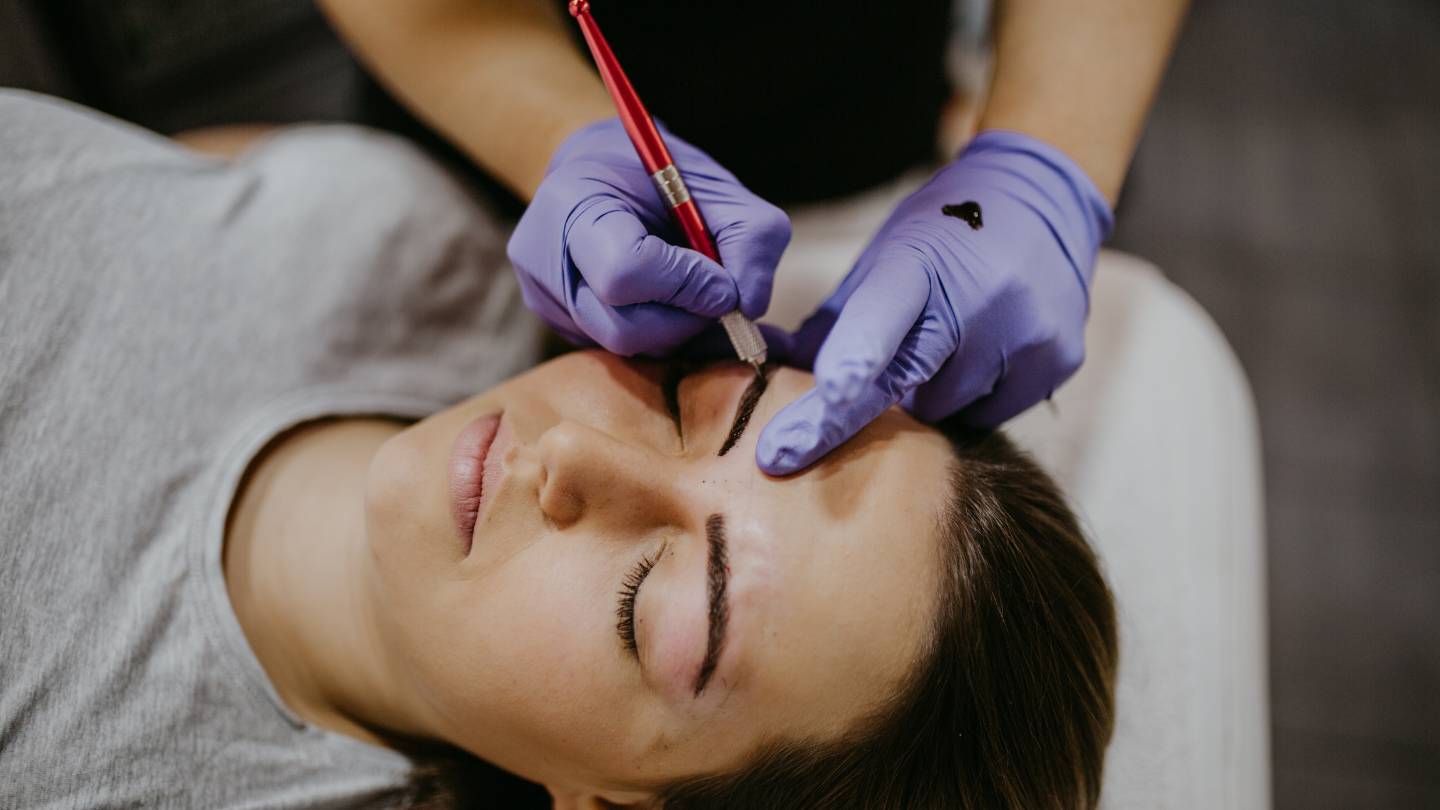Microblading has become a popular semi-permanent solution for enhancing the appearance of eyebrows, offering fuller and more defined brows. However, sometimes the results don’t turn out as expected, leading to eyebrows that are too thick.
If you’ve found yourself in this situation, don’t worry—there are steps you can take to fix this issue. This blog offers solutions, correction options, and important tips to help you regain your desired look.
Whether you are a first-timer or dealing with a microblading mishap, this guide will help you navigate the situation.
Let’s get straight to the point.
If your microblading results are too thick, don’t panic; there are solutions. First, wait 4-6 weeks for the healing process, as brows often appear thicker initially.
Communicate with your microblading artist for potential fixes, such as touch-ups to adjust the thickness. If the brows remain too thick, options like saline removal, laser treatments, or lightening can help.
Makeup can temporarily conceal thick areas as you explore longer-term solutions. To avoid overly thick brows, choose an experienced artist, communicate clearly, and start with a subtle look.
Patience and collaboration with your artist are key to achieving your desired results.
Steps To Take If Microblading Is Too Thick
If you are unhappy with the thickness of your microbladed eyebrows, there are several solutions to explore.
1. Wait For The Healing Process To Complete
Right after microblading, eyebrows often appear darker and thicker than the final result. This is normal, as the pigment will fade during the healing process.
Wait for at least 4-6 weeks to see the outcome before making any decisions.
2. Speak To Your Microblading Artist
If you’re worried about the thickness of your eyebrows, it’s important to communicate openly with your microblading artist. They can assess the situation and suggest potential solutions.
3. Consider A Touch-Up Or Correction
Most microblading procedures include a touch-up session after 6-8 weeks. During this session, the artist can refine the brows, adjusting the thickness to better suit your preferences.
They may also correct uneven areas or reshape the brows for a more natural look.
4. Explore Lightening Options
If the brows remain too thick after healing, lightening the pigment is an option. Techniques such as saline removal or laser treatments can help fade the pigment without completely removing it.
Saline removal involves injecting a saline solution into the skin to break down the pigment, while laser treatments use light to target and fade the ink. Both methods can be effective but may require multiple sessions depending on the pigment’s intensity.
5. Microblading Removal
Complete removal may be necessary in cases where the thickness is too severe. Laser removal is the most effective method, using targeted lasers to break down the pigment.
However, laser removal can be costly and may require several sessions, so it is often considered a last resort.
6. Concealing With Makeup
As a temporary fix, you can use makeup to adjust the appearance of your eyebrows. Use a concealer or foundation to mask areas of the brow you feel are too thick, or lightly fill your brows with a pencil to create a softer look.
This option is not permanent but can help you feel more comfortable with your appearance until a long-term solution is found.
Why Getting The Right Thickness Matters?
Achieving the correct eyebrow thickness with microblading is essential for several reasons:
- Natural Appearance: Microblading aims to create natural-looking eyebrows. Too much thickness can lead to an artificial, drawn-on look.
- Facial Balance: Eyebrows play a key role in framing the face. If they are too thick, it can throw off facial symmetry.
- Long-Term Results: Microblading is semi-permanent. The thickness of the strokes affects how long the results last and how often touch-ups are needed.
- Client Satisfaction: The goal is to give clients brows they feel confident in. Achieving the right thickness is key to meeting their expectations.
- Comfort: Overly thick brows can feel heavy and uncomfortable. Finding the perfect thickness creates a more natural and comfortable look.
Common Issues When Microblading Is Too Thick
When microblading results in eyebrows that are too thick, several common concerns arise:
1. Unnatural Look
Thick eyebrows can appear overly bold or harsh, which may not match the client’s subtle, natural look.
2. Limited Styling Options
Styling or reshaping thick microbladed eyebrows can be difficult. Clients may find it hard to achieve their preferred arch or shape.
3. Contrast With Natural Hair
Thicker strokes can stand out too much against the client’s eyebrow hair, creating a jarring visual contrast.
4. Colour Mismatch
When the microbladed strokes are too thick, blending the pigment with the natural brow hair becomes harder. This can result in an uneven or unnatural appearance.
5. Increased Fading Visibility
Thick strokes fade unevenly, making the pigment breakdown more visible and potentially giving the brows a patchy look over time.
Professional Correction Procedures
Professional correction procedures may be needed if your brows are still too thick after healing and a touch-up isn’t enough. These options should be discussed with your microblading artist or a qualified aesthetic professional.
1. Saline Removal
Saline removal is a common method for fading or removing microblading pigment. A saline solution is injected into the skin, which breaks down the pigment, allowing the body to absorb and eliminate it over time.
This procedure is less invasive than laser removal and is effective for lightening overly thick microblading strokes.
2. Laser Removal
Laser removal is another option for removing or fading too-thin microblading. This method uses a laser to target the pigment in the skin, breaking it down so the body can naturally process it.
Laser removal is more invasive than saline removal and may require multiple sessions, depending on the thickness and darkness of the brows.
3. Brow Lightening
For clients who want to avoid complete removal, lighting procedures can soften the appearance of overly thick brows. This process typically involves applying a lightening agent to the area to reduce the intensity of the pigment.
Conclusion
Microblading can transform your eyebrows and enhance your appearance, but sometimes, the results may be too thick for your liking. Thankfully, several ways exist to address this issue, from fully allowing the brows to heal to professional correction techniques like saline or laser removal.
The key to achieving your ideal look is clear communication with your microblading artist, patience during the healing process, and considering touch-ups or adjustments if necessary.
By understanding the steps to correct overly thick brows and working closely with a skilled artist, you can regain confidence in your appearance and enjoy the long-lasting benefits of microblading.
FAQs About Microblading
What Should I Do If My Microblading Is Too Thick?
If your microblading is too thick, the first step is to remain calm. Contact your microblading artist immediately to discuss your concerns. They can guide you on addressing the thickness or schedule a touch-up appointment.
Is It Normal For Microblading To Look Too Thick Initially?
It’s not uncommon for microblading to appear thicker immediately after the procedure. The pigment is fresh, and the strokes may seem more defined. However, if you feel that it’s excessively thick, it’s crucial to communicate with your artist.
Can Microblading Thickness Be Adjusted During The Healing Process?
Microblading will go through various stages of healing, and the thickness may appear different during each stage. While some adjustments can occur naturally as the skin heals, significant changes may require a touch-up session.
How Long Should I Wait Before Addressing Thickness Concerns?
It’s recommended to wait until the healing process is complete before assessing the final results. This typically takes a few weeks. Contact your artist for further evaluation if you still have concerns after the healing period.
Can Microblading Thickness Be Corrected With Additional Sessions?
Additional sessions, often called touch-ups, can be performed to adjust the thickness. Your artist will assess the healed results and work with you to achieve the desired outcome.



